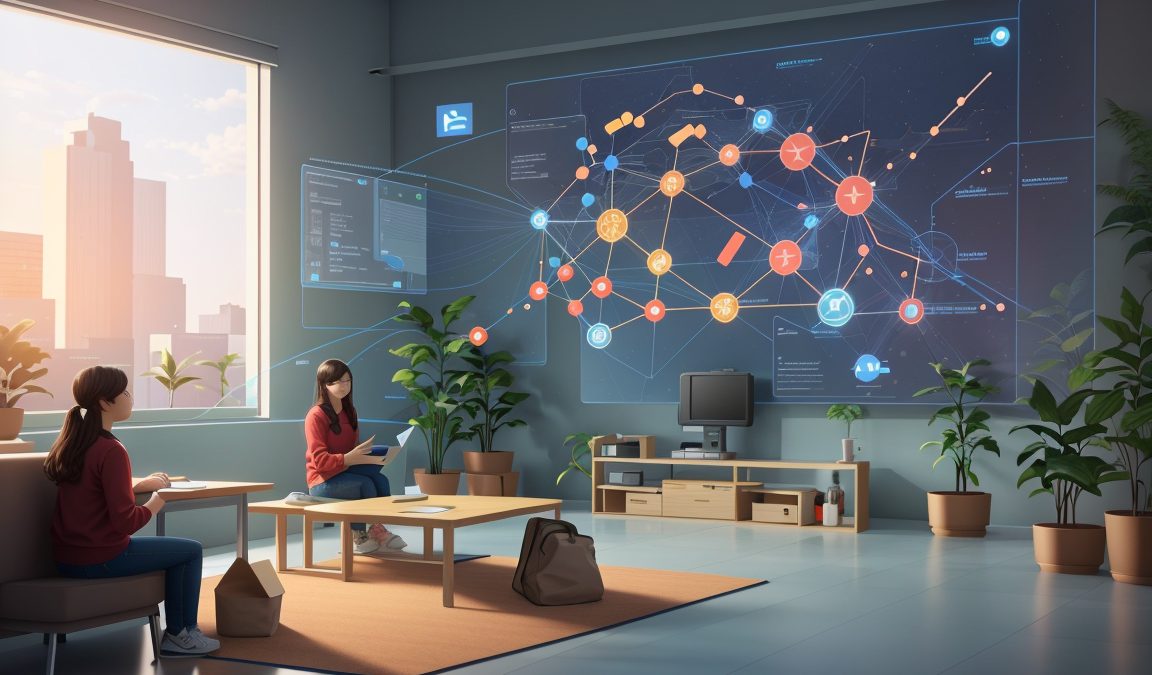
Interactive Evolutionary Computation
Let’s Create Something That Matches Your Sensibility with Interactive Evolutionary Computation!
Interactive Evolutionary Computation (IEC) is a method in which humans and computers collaborate to create something that aligns with human sensibilities. Examples of such creations include clothing design and color coordination, shoe design, fashion coordination, and even music and camera work in 3D spaces expressed as video—spanning a wide range of applications.
Overview of Interactive Evolutionary Computation
For example, imagine a user wants to design running shoes they would like to wear while jogging.
- First, the computer presents several running shoe design proposals to the user.
- Next, the user evaluates the proposed designs based on their own sensibilities and preferences, with reactions such as “I like this design!” or “This one isn’t quite right…”
- Then, the user’s feedback is sent back to the computer, which generates new design proposals based on the evaluations and presents them again to the user.
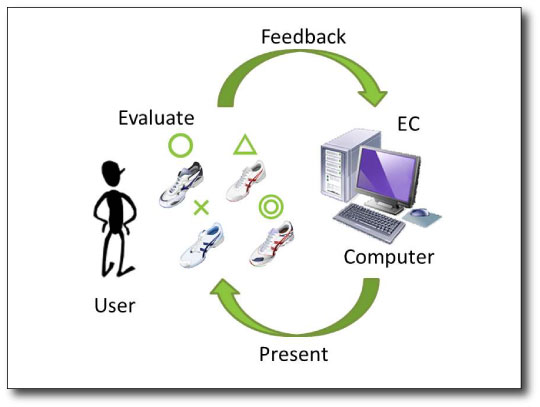
In recent years, product development fields have increasingly sought to create items that align with user sensibilities, and the application of IEC is gaining attention. However, a major challenge in IEC is the high evaluation burden placed on users. To reduce this burden, various approaches have been explored, including improvements to algorithms and evaluation interfaces. Our research focuses on reducing user evaluation burden through enhancements to the evaluation interface.
Improvement Policy for the Evaluation Interface
In conventional IEC, the typical evaluation interface requires users to assign a rating—such as on a 5-point or 10-point scale—to about 10 to 20 presented designs. However, this can cause users to hesitate in assigning scores, leading to a significant evaluation burden.

We therefore proposed an evaluation interface that avoids the cumbersome task of assigning numerical ratings. Instead, users simply select only the designs they prefer from the ones presented. To date, we have introduced several such interfaces, including the “Tournament-Based Evaluation Method,” where users evaluate designs in a bracket-style format, and “Interactive Tabu Search,” where users select only one preferred design from multiple options. In addition, we are also working on developing evaluation interfaces based on eye gaze and conversational input.
Evaluation via Tournament Format
In the tournament-based evaluation method, the user repeatedly compares two presented designs and selects the one they prefer. This approach is especially effective in reducing the evaluation burden when assessing time-based data such as music or video, as only two items are compared at a time.
There are two types of tournament-based evaluation methods: the "Standard Tournament Format," where the user selects their preferred design from the two presented, and the "Graded Tournament Format," where the user evaluates the two designs with nuanced preferences such as “strongly prefer the left design” or “slightly prefer the right design.”
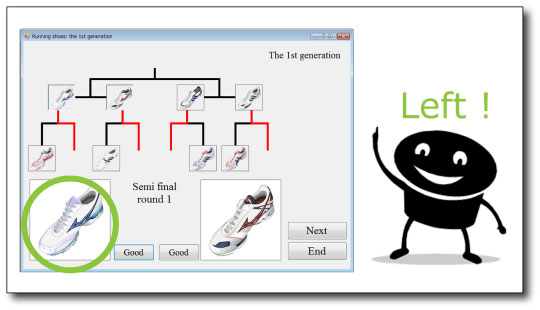
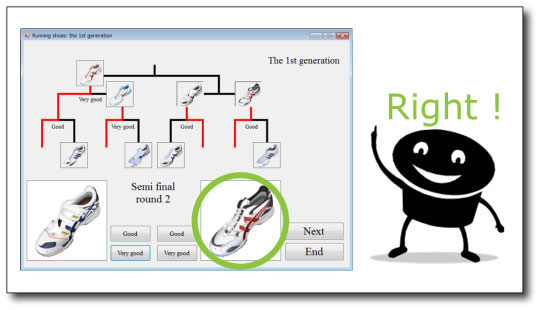
Select Only One Preferred Design
In Interactive Tabu Search, the user selects only one preferred design from a set of presented options. While it is less suitable for evaluating time-based media such as music or video—due to the need to compare multiple items at once—it simplifies the evaluation process for static images, effectively reducing the user’s evaluation burden.
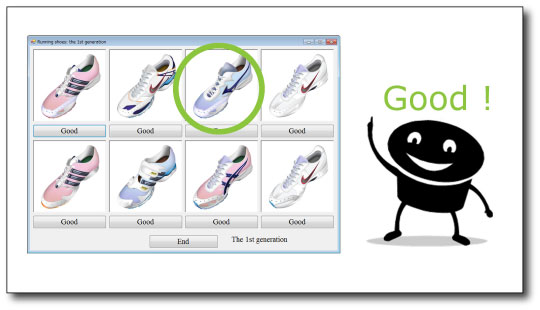
Evaluation Experiments
Up to now, we have conducted both numerical simulations—using evaluation agents generated on a computer in place of real users—and user-based evaluation experiments. The numerical simulations were used to assess the fundamental performance of the proposed methods, while the user experiments focused on evaluating ease of use from the users’ perspective.
These results indicate that both the Tournament-Based Evaluation Method and Interactive Tabu Search are effective in reducing the evaluation burden on users in IEC.
関連研究紹介
Enhancing Movie Discovery: A Serendipity-Driven Recommendation System based on Temporal Relevance of Color Features
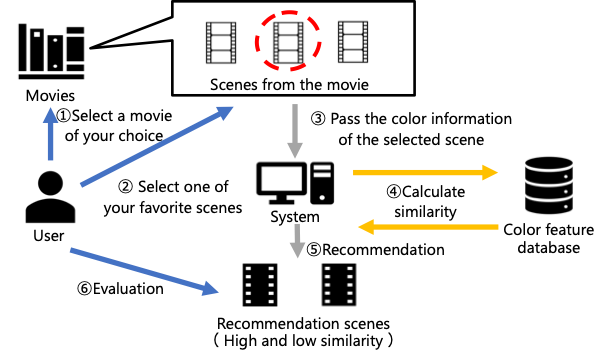
This study proposes a novel recommendation system for subscription-based movie streaming services, which have become increasingly popular in recent years. These platforms host vast libraries of movie content, often making it difficult for users to choose what to watch. To address this issue, many streaming services have implemented recommendation systems. However, traditional movie recommendation systems tend to rely on objective categorizations or subjective user ratings, which can lead to overly predictable suggestions.In contrast, our proposed system leverages temporal color data from films to introduce serendipity—the experience of unexpected yet pleasant discoveries—into the movie selection process. The goal is to provide recommendations that go beyond user expectations and introduce them to films they might not have otherwise encountered.Experimental results suggest the effectiveness of the proposed approach, showing that the system is capable of recommending unexpectedly enjoyable movies. This research opens up the possibility for users to discover new films they wouldn’t have come across through conventional recommendation systems, ultimately enhancing user satisfaction with the movie-watching experience.
An IEC-driven Optimization of Gestures to Enhance Personality Traits in Communication Robots
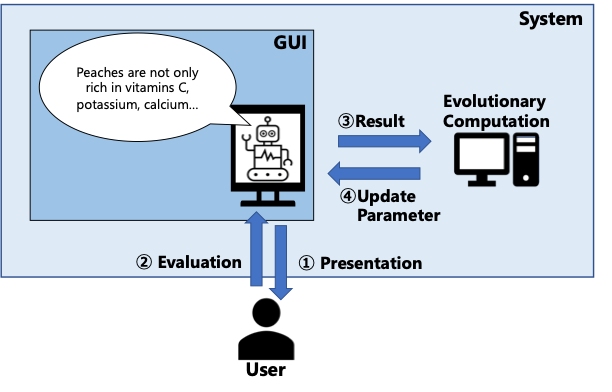
This study proposes a system that optimizes the gestures used by communication robots to express personality traits based on individual user preferences. For a communication robot to evoke a sense of familiarity and connection, it must convey a friendly impression. However, conventional robot personalities are typically designed based on generalized human impressions and do not account for the preferences of individual users.To address this issue, the proposed system employs Interactive Evolutionary Computation (IEC) to optimize the gestures that express a robot's personality in accordance with the specific preferences of the user. Experimental evaluations were conducted to verify the system’s effectiveness. The results suggest that the proposed approach can improve users’ impressions of the robot and enhance their sense of closeness to it.This research contributes to enabling robots to provide more natural and personalized communication, ultimately improving user satisfaction and fostering a greater sense of affinity toward the robot.
References
Hiroshi Takenouchi, Masataka Tokumaru, Noriaki Muranaka, “Tournament-style Evaluation using Kansei Evaluation”, International Journal of Affective Engineering, Vol.12, No.3, pp.395-407, 2013-09.
Hiroshi Takenouchi, Masataka Tokumaru, Noriaki Muranaka, “Interactive Evolutionary Computation Using a Tabu Search Algorithm”, IEICE TRANSACTIONS on Information and Systems, Vol.E96-D, No.3, pp.673-680, 2013-03.
Hiroshi Takenouchi, Masataka Tokumaru, Noriaki Muranaka, “Tournament Evaluation System Applying Win-Lose Result Presumption Considering Kansei Evaluation by Multiple People”, Journal of Advanced Computational Intelligence and Intelligent Informatics, Vol.16, No.3, pp.453-461, 2012-05.
Takenouchi, H., Dommae, S., & Tokumaru, M. (2014). Construction of a virtual fitting system for men’s fashion coordination using parallel interactive tabu search [並列対話型タブーサーチを用いたメンズファッションコーディネートのための仮想試着システムの構築]. Proceedings of the 2014 IEICE General Conference, D‑8‑7. Niigata, Japan.
Takenouchi, H., Dommae, S., & Tokumaru, M. (2013). A Study on Parallel Search Interactive Tabu Search [並列探索を用いた対話型タブーサーチに関する検討]. Proceedings of the 27th Annual Conference of the Japanese Society for Artificial Intelligence, 203‑3in. Toyama, Japan.
Kaito Nagayasu, Emmanuel Ayedoun, Masataka Tokumaru, “Enhancing Movie Discovery: A Serendipity-Driven Recommendation System based on Temporal Relevance of Color Features”, The 24th International Symposium on Advanced Intelligent Systems, TM1-4, pp.18-24, 2023-12 (Gwangju, Korea).
Ryoto Mikawa, Emmanuel Ayedoun, Masataka Tokumaru, “An IEC-driven Optimization of Gestures to Enhance Personality Traits in Communication Robots”, Joint 13th International Conference on Soft Computing and Intelligent Systems and 25th International Symposium on advanced Intelligent Systems (SCIS&ISIS 2024), S-1-E-5, 2024-11 (Himeji, Japan).








